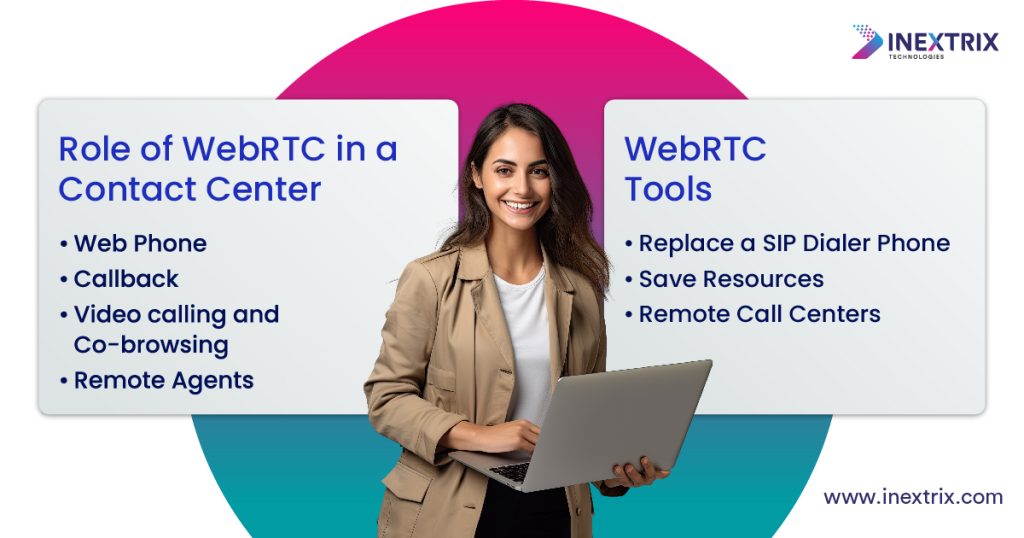Undoubtedly, WebRTC has gained widespread adoption. It has been in the industry for more than a decade now. Certainly, several industries have already adopted this browser-based real-time communication technology. Certainly, a custom WebRTC development company helps in building different communication tools that leverage the potential of browser technology.
Along with several other communication and collaboration tools, a contact center solution is one of the tools that leverage the full potential of WebRTC technology. Particularly in contemporary cloud contact center solutions, this technology facilitates web real-time communication. Furthermore, it empowers cloud-based contact centers to noticeably enhance customer experience. Moreover, it reduces telephony costs linked to traditional phone systems. Additionally, it boosts agent efficiency and productivity and streamlines customer service operations.

WebRTC technology revolutionizes contact centers by empowering them with robust web calling capabilities, elevating customer experience, streamlining IT operations, and boosting agent productivity. Across various industries, enterprise websites now integrate WebRTC-powered web calling, marking a transformative shift in contact center dynamics. As a result, this advancement enhances customer experience (CX) and delivers cost-effective telephony solutions, improves IT efficiency, and simplifies customer service operations. The result is a smart, seamless, economical, and efficient approach to handling customer service. Moreover, it positions contact center agents for success and productive outputs.
In short, WebRTC has a crucial role in empowering call centers and call center software solutions. In this blog post, we will discuss more details about WebRTC and its role in the call center industry to augment overall performance and boost advantages.
So, what are we still waiting for? Let’s delve deeper to understand WebRTC and its role in the call center industry.
1) Understanding WebRTC
WebRTC is an acronym for Web Real-Time Communication. This technology is a revolutionary technology, which has brought transformative shifts in the online communication industry. Fascinatingly, WebRTC enables real-time audio, video, and data sharing directly within web browsers. Simply put, you don’t need any other software, plug-ins, extensions, and applications to develop.
Originally, WebRTC was developed as an open-source project to eliminate the need for plugins. Moreover, it provides seamless and secure peer-to-peer communication. Major browsers, including Chrome, Firefox, Safari, and Edge, natively support WebRTC. Therefore, it is standard technology for web-based interactions in call centers or any other industry.
WebRTC technology facilitates high-quality audio and video calls, along with real-time data exchange in the call center environment. Moreover, it fosters collaboration through features like file sharing and text chat. Furthermore, with a focus on security, WebRTC employs encryption protocols to safeguard user communications and data. Its plugin-free nature ensures user convenience. Moreover, it allows a versatile range of applications beyond traditional communication. In essence, WebRTC serves as a foundational technology that enhances user experiences and drives innovation in call centers.
2) Role of WebRTC in a Contact Center to Improve the Work Efficiency of the Agent

Role of WebRTC in a Contact Center
Certainly, with the right mindset and innovative strategies, WebRTC developers can build different real time communication applications for call centers. They can integrate this technology into different on-premises and cloud contact center solutions. Some of the common areas in which WebRTC plays a pivotal role are briefly explained hereunder by an experienced company.
Web Phone
A WebRTC web phone is a browser-based communication tool that resembles the layout of a mobile SIP dialer. Moreover, it also provides features of this SIP Softphone. This web phone uses browser-based web real-time communication technology. Ideally, it enables users to make voice and video calls directly from web browsers without the need for additional software. It offers real-time communication, cross-platform support, and integration capabilities. Furthermore, WebRTC web phones are user-friendly and compatible with various devices.
In a call center, a web phone can work as an integral tool because you can integrate it into the call center software. Unlike SIP dialer phones, agents will not need to use multiple solutions. They will stay away from the intricacies of managing two different solutions and logging into two different solutions.
Besides real-time communication features, WebRTC based web phones prioritize security through encryption. As a result, it ensures private and secure conversations. This makes it the most suitable for call centers.
Callback
All call center solutions will register all types of calls. Certainly, this includes a list of missed calls, abandoned calls, dropped calls, ringing calls, and of course, ongoing calls or conference calls. Undoubtedly, dropped and abandoned calls can be a missed opportunity. Therefore, it is necessary to connect with these clients in one way or another. Thanks to WebRTC which lets you develop a callback feature. Now, agents can see a list of dropped and abandoned calls in their software. Simply clicking on the number or callback button, the system will connect the agent with the caller that had dropped or abandoned the call.
Video Calling and Co-browsing
Unified communication or usage of rich communication mediums is inevitable for businesses. Therefore, it is necessary to add rich communication features. Video conferencing and co-browsing or screen sharing features are a must to add to the solutions for call centers. Thanks to WebRTC, you can easily integrate these features.
Remote Agents
Virtual call centers have been in the industry for decades. However, the pandemic gave it a real boost and popularity. Right now, several call centers operate as remote or virtual call centers that recruit agents across the globe and let them work from anywhere. SIP Softphone apps have several limitations of device, platform, etc. However, WebRTC based communication tools are platform independent. Therefore, by using these tools one can build a complete and reliable remote work environment for remote agents.
WebRTC to Improve the Work Efficiency of Agents
Call centers can implement different tools and technologies using the right partner that helps with custom WebRTC development. Despite adding one WebRTC tool or multiple tools, you can leverage several advantages. Certainly, improving agent efficiency is one of the major advantages and this advantage helps in bringing several advantages to the table such as:
- Better customer satisfaction
- Enhanced operational efficiency
- Increased performance and productivity
- Improved morale
Are you finding these facts interesting?
Then, now is the time to explore how WebRTC tools integrated into a solution for call centers can leverage the advantage of boosted efficiency.
2.1. Replace a SIP Dialer Phone
A SIP phone is accessible through the same device and platform. Moreover, it is available as an independent solution to make and take calls. On the other hand, the contact center software is useful to use other features. Simply put, agents have to manage two different solutions. Moreover, they need to keep logged in to both of these communication tools. Additionally, the system has several other limitations and restrictions.
Conversely, WebRTC can resolve all these concerns easily with its flexible nature and simplified compatibility. Moreover, WebRTC web phones are integrated within the software for call centers. Therefore, agents don’t need to manage two different solutions. Certainly, this is reflected in the agent’s efficiency and accuracy.
2.2. Save Resources
WebRTC implements a calling facility within the browser. As we are aware, call center solutions are web based apps. Simply put, within a single system agents will get access to both communication and call center features. Therefore, they will not need to switch back and forth between two solutions. This will save a lot of time for agents. Moreover, a call center can save funds and otherwise get invested in managing and maintaining two different communication tools. These saved funds are useful in managing different training sessions and other tools that can help in boosting agent efficiency.
We recommend you read one of our interesting blog posts covering WebRTC and SIP Softphone: Everything You Need to Know. This covers how WebRTC and SIP Softphone are making a difference for any business. Certainly, you will learn the difference between a SIP Softphone and a WebRTC web phone. Moreover, multiple interesting facts are clearing all doubts about these two different communication phone solutions available in the VoIP industry.
2.3 Remote Call Centers
The COVID 19 pandemic increased the preference for a working from home model. Certainly, it saves time for commuting. Moreover, it helps in giving flexibility to work from home. Therefore, agents can get the comfort of the home desk and work in their preferred environment. Additionally, WebRTC based solutions are platform independent and compatible with all systems. Therefore, agents can work from anywhere, at any time without any need for carrying the same laptop everywhere to work. This also gives relief to agents, which will reflect in their efficiency and productivity.
3) Benefits of WebRTC in Contact Centers

There are several advantages of investing in a WebRTC based solution or application and integrating it into your contact center software. Let’s discuss five major advantages of using these tools.
3.1 Enhanced Customer Satisfaction
Modern call centers have to deal with unified communication needs. Therefore, their communication tools have to support different communication channels. WebRTC supports audio and video calling. Moreover, it provides features like data exchange, file sharing, screen sharing, conference calling, and more. Therefore, agents can efficiently provide the required support through the preferred communication channel of the customer. As a result, customer satisfaction levels will be increased substantially.
3.2 Improve Goal Conversion
Video calling has multiple advantages in the call center settings. For example, it helps in performing important jobs like video KYC verification. This helps improve customer satisfaction because now they don’t need to visit the bank physically to get their documents verified. Moreover, it helps in sales because agents can take verbal and nonverbal clues based on their skills and proficiency to drive conversations in their favor to make more sales. Likewise, there are several amazing use cases of WebRTC in the call center industry that prove its worth in increasing goal conversion.
3.3 Better Problem Solving
WebRTC supports real time exchange of data, files, screens, and more. Moreover, it provides insightful reports. As a result, agents can possess excellent problem solving capabilities. Rather than delaying problem resolution due to a lack of tools, now agents can take immediate actions and resolve concerns. This helps in increasing the FCR (First Call Resolution) rate.
3.4 Scalability
WebRTC can support unlimited parallel calls because all it uses is browser technology. As a result, there are no limitations associated with WebRTC in scalability. You can achieve instant scalability. Moreover, you can scale up the system based on your requirements without any technical challenges.
3.5 Cost Efficiency
WebRTC works on browser technology. Therefore, it does not require any added technical support, paid extensions, or tools to make calls. Moreover, it is integrated into a contact center solution. Therefore, it does not demand any additional cost for maintenance. In short, it is a low maintenance yet powerful communication tool that supports real time communication in the form of voice, video, and data. Therefore, it helps in reducing operational expenses considerably. As a result, call centers can receive a more cost efficient solution for their business.
Concluding Note
The call center industry is one of the most competitive industries in the world. Certainly, there are several opportunities, but at the same time, there are several challenges to deal with. To overcome a majority of challenges, call centers need to invest in the right and skilled people, as well as technologies. Certainly, WebRTC is the technology that bestows several advantages to call centers. Moreover, it helps in elevating the performance of multiple other tools and manpower in the call center. As we have discussed in this blog post, there are numerous examples of implementing WebRTC to boost agent efficiency and leverage several other advantages.
We have been helping businesses to take advantage of this browser based real time communication technology with our development and customization services. We have expertise in the call center industry and exploiting the power of WebRTC for the call center industry. To discuss how our WebRTC development service can benefit your call center, please contact us.
